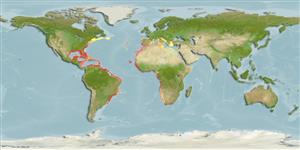Classification / Names
Common names from other countries
Main reference
Size / Weight / Age
Max length : 124 cm TL male/unsexed; (Ref. 5217); common length : 75.0 cm TL male/unsexed; (Ref. 2683); max. published weight: 32.0 kg (Ref. 27584)
Length at first maturity
Lm 66.0 range ? - ? cm
Environment
Marine; brackish; reef-associated; oceanodromous (Ref. 51243); depth range 1 - 350 m (Ref. 7097), usually 1 - 200 m (Ref. 55173)
Climate / Range
Subtropical, preferred 27°C (Ref. 107945); 45°N - 33°S, 98°W - 14°E
Distribution
Eastern Atlantic: Portugal to Angola, including the western Mediterranean. Western Atlantic: Nova Scotia, Canada and northern Gulf of Mexico to Uruguay (Ref. 7251), including the Greater Antilles (Ref. 9626). Absent from eastern Lesser Antilles (Ref. 26938). Indian Ocean records are probably misidentifications of Caranx ignobilis. Reports from Pacific refer to Caranx caninus, which may be conspecific.
Countries | FAO areas | Ecosystems | Occurrences | Introductions
Short description
Dorsal
spines
(total): 9;
Dorsal
soft rays
(total): 19-22;
Anal
spines: 3;
Anal
soft rays: 15 - 18. Diagnosis: Scutes on lateral line 23 (Ref. 57392) to 42 (Ref. 13442). No scales on chest (Ref. 13442), except a small mid-ventral patch in front of pelvic fins (Ref. 13442, 57392). Upper profile of head steep (Ref. 13442). Maxilla ending approximately below (Ref. 13442, 57392) or beyond (Ref. 57392) posterior edge of eye (in adult). Front of soft dorsal and anal fins elevated; olivaceous to bluish green dorsally, silvery to brassy on the sides; prominent black spot posteriorly on gill cover at level of eye, another at upper axil of pectoral fins, and often a third on lower pectoral rays; caudal yellowish (Ref. 13442).
IUCN Red List Status (Ref. 115185)
Threat to humans
Reports of ciguatera poisoning (Ref. 4690)
Human uses
Fisheries: commercial; gamefish: yes
Tools
Special reports
Download XML
Internet sources
Estimates of some properties based on models
Phylogenetic diversity index
PD50 = 0.5000 many relatives (e.g. carps) 0.5 - 2.0 few relatives (e.g. lungfishes)
Trophic Level
3.6 ±0.4 se; Based on diet studies.
Resilience
Medium, minimum population doubling time 1.4 - 4.4 years (Assuming tm 3-4)
Vulnerability
Moderate vulnerability (41 of 100)
Price category
